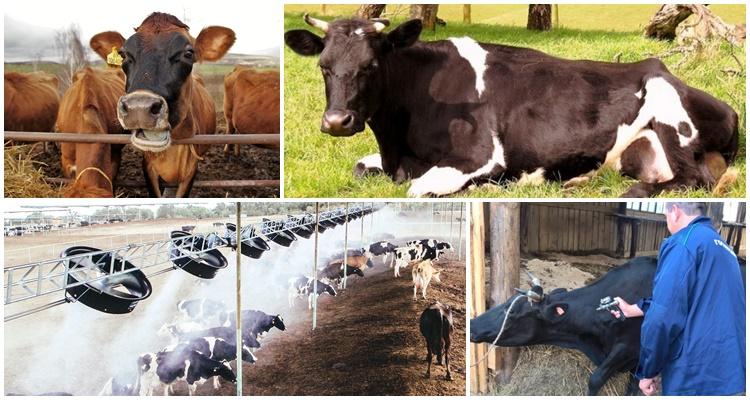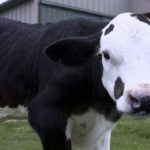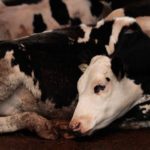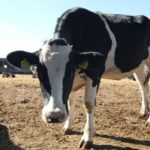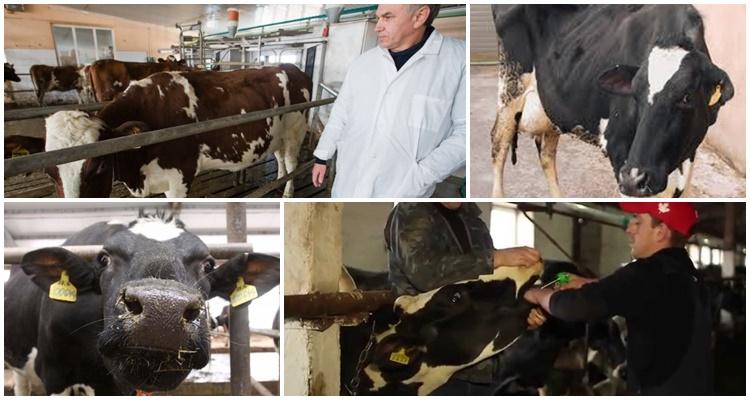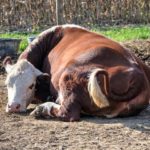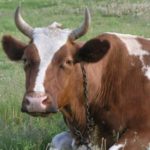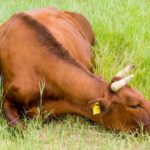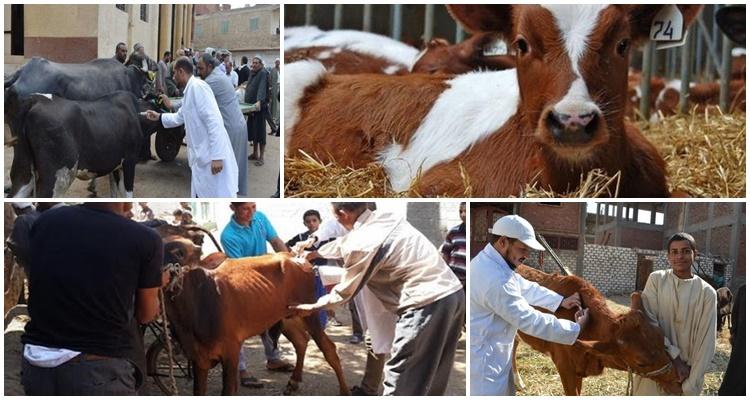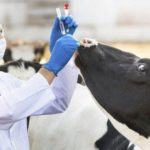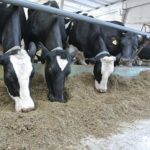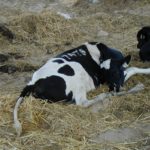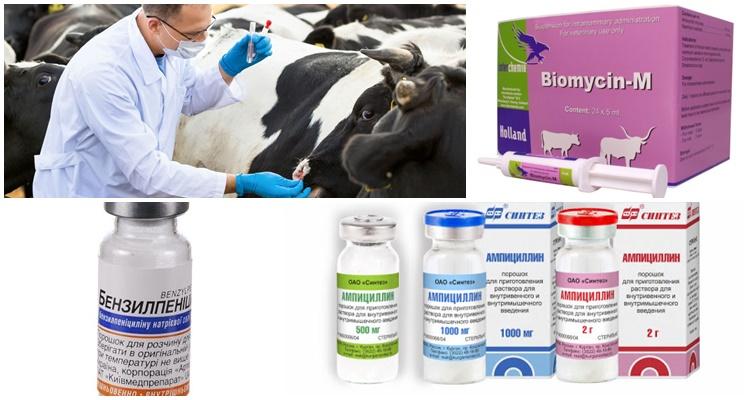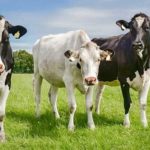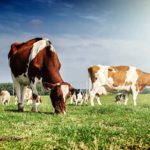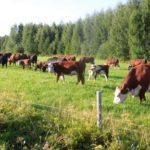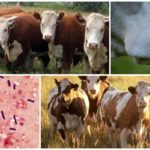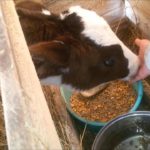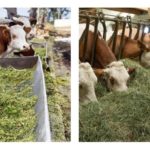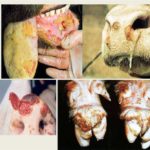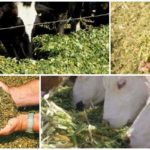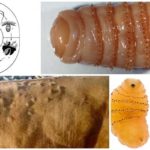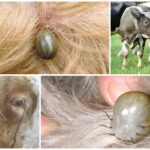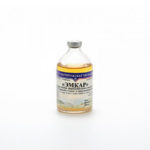Clostridiosis is a bacterial infection of cattle. Against the background of infection with its pathogens (clostridia), skin and intestinal diseases develop, as well as tetanus and brads. The danger of acute clostridiosis in cattle lies in the rapid development of symptoms that lead to the death of animals. The chronic course of the disease reduces milk yield and undermines the immunity of calves. Clostridia quickly penetrate the environment and have a high survival rate.
Epizootiological characteristics
A favorable environment for the development of clostridiosis is humidity and temperature of +35 degrees. Pathogens often colonize chernozem soil. The disease is transmitted orally-fecally or through lesions on the skin. Based on the method of infection by bacteria, a distinction is made between food-borne and traumatic clostridiosis.
Pathogens
Clostridia are bacteria that form spores. They are anaerobic microorganisms that do not require oxygen for development. Vegetative dividing cells of clostridia are similar to rods. Spore cells form inside. They sleep while the bacteria receive enough nutrition from the environment - carbon and nitrogen.
When nutritional resources are depleted, the vegetative clostridia cells die and the bacteria survive as spores. Under favorable conditions, they begin life again. There are two types of clostridia:
- pathogenic - enter the body, take root, multiply, cause food infections;
- opportunistic - live and accumulate in the body, food, cause food poisoning when immunity decreases due to other diseases.
The common property of both types of bacteria is to produce and release toxins into the environment. Cattle diseases developing against the background of clostridiosis:
- botulism;
- tetanus;
- emcar;
- malignant edema;
- anaerobic enterotoxemia.
First-calf heifers with clostridiosis develop necrotizing mastitis. The disease is accompanied by tissue death, the formation of bubbles with liquid and general poisoning of the body through the blood. Cattle become infected with clostridia through water, feed, soil and manure.In animals, bacteria concentrate in the intestines and mucous membranes. They also enter the bloodstream through wounds.
Mechanism of the infectious process
Spores of pathogenic clostridia enter the animal's intestines and begin to form vegetative cells. In the process, bacteria release waste products - toxins that cause poisoning. Toxic substances also enter the bloodstream and poison the liver, kidneys, nerve and muscle fibers. As a result, acute clostridiosis develops. Opportunistic bacteria are present in the intestinal microflora and develop when beneficial microorganisms are suppressed, for example, after treatment with antibiotics.
Clostridia are found in animal feces. Contaminated manure is used to fertilize the soil on which crops are grown for feed or cattle are grazed. This is how clostridiosis is transmitted from sick cows to healthy ones. Bacteria are found in haylage and silage when harvesting rules are violated. Animals that are fed protein are susceptible to clostridiosis.
Animal proteins also contribute to the development of the disease. The spread of clostridia poses a big problem for agriculture, as it causes chronic disease in dairy cows.
Main features
General symptoms of clostridiosis in cows:
- lack of appetite;
- refusal of water;
- lethargy;
- diarrhea;
- manure mixed with blood;
- convulsions;
- loss of balance.
Signs indicating the type of bacteria and the disease caused by it:
- the animal has poor vision, cannot swallow food or water, liquid pours out through the nose, saliva flows - botulism;
- muscles become hard, sweat is released profusely - tetanus;
- swelling, rapid breathing and pulse - malignant edema;
- hot and cold swellings under the skin, crunchy when squeezed, the animal staggers when walking - emkar.
Calves with clostridiosis often develop anaerobic enterotoxemia. Symptoms of the disease:
- temperature rise to +42 degrees;
- impaired coordination of movements;
- muscle contraction;
- increased heart rate and breathing.
Calves tolerate emphysematous carbuncle or emcar without edema, but the temperature rises in young animals and adult animals. Other forms proceed without heat. Chronic clostridiosis is a disease with mild symptoms:
- poor appetite;
- lapping water with tongue;
- wrinkled, dull coat;
- non-healing ulcers on the tail and hooves;
- lack of sucking reflex in calves.
Due to the high mortality rate among first-calf heifers and newborns, clostridiosis causes great damage to dairy farms.
Diagnostics
Infection with clostridia is determined using laboratory tests. Examination of tissue, fecal and blood samples helps differentiate poisoning from toxins of various types of bacteria from diseases with similar symptoms:
| Form of clostridiosis | Research method | Differential diagnosis |
| With botulism | Determination of botulinum toxin in blood | With food poisoning, anthrax, ketosis, listeriosis |
| With tetanus | Detection of clostridia and their metabolic products in a tissue sample from a wound | With rabies, tetany |
| Co malignant edema | Studying exudate under a microscope, cultivating microorganisms | Exclude emkar |
| Anaerobic enterotoxemia | Examine the intestinal sample and its contents for the presence of the toxin | With pasteurellosis |
| Emkar | Analysis of muscle fibers using microscopy and bioassay | Shared with malignant edema and anthrax |
Using endoscopy, yellow plaques are detected on the intestinal walls. They indicate pseudomembranous colitis, which also develops when infected with anaerobic bacteria and clostridiosis. The laboratory examines the water and feed given to the cows to determine the source of contamination.
Clostridiosis is diagnosed after the death of the animal during autopsy. The disease causes the following changes in tissues and organs:
- bloating, crunching of subcutaneous tissue;
- muscle inflammation;
- release of foamy liquid when pressed.
Enterotoxemia is characterized by:
- accumulation of fluid in the abdominal cavity;
- thickening of the intestinal walls;
- enlarged lymph nodes;
- hepatic, renal hemorrhage.
Gray muscles like boiled meat and dark, thick blood are signs of tetanus or botulism.
Treatment of cattle for clostridiosis
At the first signs of disease, animals are isolated and transferred to a special regime:
- brought into a separate stall;
- change the litter frequently;
- do not feed for two days;
- from the third day they are fed small portions of light food;
- leave water in the drinking bowl and change it often;
- wash out the intestines.
The room in which cows sick with clostridiosis were located is disinfected with halogen agents that destroy anaerobic bacteria - with iodine, bromine or chlorine. Drug therapy necessarily includes treatment with antibiotics effective against clostridia:
- "Ampicillin";
- "Amoxicillin";
- "Chlortetracycline";
- "Biomycin";
- "Bicillin-5";
- "Sulfadimethoxine";
- "Benzylpenicillin";
- "Metronidazole".
Drugs against concomitant diseases are prescribed after test results and diagnosis:
- botulism - administration of anti-botulinum serum on the first day after the onset of the disease, enemas with a solution of bicarbonate of soda - 30 grams per 15 liters of water, sodium chloride droppers 2 liters twice a day. In case of exhaustion, a 40% glucose solution is also administered, and caffeine is administered to stimulate the heart. The oral mucosa is washed with a solution of potassium permanganate;
- tetanus - administration of a dose of serum of 80 thousand AE and symptomatic therapy with chloral hydrate, laxatives and sedatives;
- malignant edema - opening and cleansing swollen areas of skin with hydrogen peroxide, injections of a 4% Norsulfazole solution intramuscularly, intravenous administration of camphor serum and saline;
- emkar - the rapid development of the disease can be stopped with the help of antibiotics. Penicillin, which is administered 3 times a day, is especially effective. Dead tissue is surgically removed, drainage is placed and disinfected;
- anaerobic enterotoxemia - treatment with antibacterial drugs is combined with the administration of serum and probiotics.
In the event of an outbreak of clostridiosis, the farm is closed for quarantine; it is prohibited to export sick animals and import healthy ones. An autopsy of the dead livestock is carried out in separate rooms of the cattle burial ground, and then the bodies and samples are burned.
Probability of death
Survival rates for clostridiosis are:
- adult cows - 25%;
- calves - 10%.
There are also animal carriers of bacteria that do not show symptoms of the disease.
Preventive actions
There is a vaccine against clostridiosis that forms immunity in animals in 21 days. Cattle of any age are vaccinated. Contraindications include the last month of pregnancy and the rehabilitation period after sterilization.Prevention of the spread of the disease includes:
- maintaining cleanliness in premises for keeping cattle;
- carrying out disinfection every month;
- feeding with high-quality feed from trusted manufacturers;
- mandatory inclusion of roughage in the diet;
- reducing the proportion of protein in the diet;
- studying the epizootic situation and the location of cattle burial grounds in the region when choosing pasture;
- Regular cleaning of animal hooves.
At the first symptoms of clostridiosis, you need to isolate the animal and call a veterinarian. Botulism and emphysematous carbuncle develop quickly and cause mass mortality in cattle. Domestic and European farmers fight clostridiosis with the help of probiotics with bacteria that suppress the activity of anaerobes. The main way to prevent the disease is disinfection of premises.
Before treating with halogen agents, you need to remove manure and litter and wash the floor with a disinfectant solution. Clostridia accumulate in deep layers of dirt into which antiseptics do not penetrate.
A preventive measure against clostridiosis is the addition of antibiotics to the feed that kill anaerobic bacteria. But due to the emergence of resistant strains and the discovery of drug residues in meat, this method of combating the disease is not effective. Young animals that eat food with antibacterial drugs have reduced immunity. As a result, antibodies are not produced after vaccination.
Animals that are kept in stalls and fed mainly with concentrates are predisposed to infectious diseases. As a result, the metabolism and intestinal microflora of livestock are disrupted. A balanced diet, including concentrated, roughage and succulent food, will help avoid the development of pathogenic bacteria.

